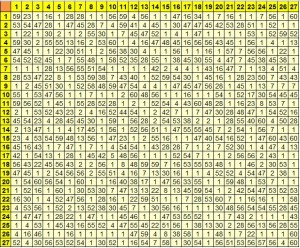The Siribhoovalaya (Kannada: ಸಿರಿಭೂವಲಯ) is a work of multi-lingual literature written by Kumudendu Muni, a Jain monk. The work is unique in that it employs not alphabets, but is composed entirely in Kannada numerals.[1] The Saangathya metre of Kannada poetry is employed in the work. It uses numerals 1 through 64 and employs various patterns or bandhas in a frame of 729 (27×27) squares to represent alphabets in nearly 18 scripts and over 700 languages.
Some of the patterns used include the Chakrabandha, Hamsabandha, Varapadmabandha, Sagarabandha, Sarasabandha, Kruanchabandha, Mayurabandha, Ramapadabandha, Nakhabandha, etc. As each of these patterns are identified and decoded, the contents can be read.
The work is said to have around 600,000 verses, nearly 6 times as big as the ancient Indian epic Mahabharata. Totally there are 26 chapters constituting it a big volume of which only three have been decoded.The author expounds that many philosophies which existed in the Jain classics are eloquently and skillfully interpreted in the work. It is also claimed to consist of works in several languages including Sanskrit, Marathi, Telugu, Tamil, Prakrit, etc., apart from Kannada. Different languages can be realised by assigning different alphabets to different numbers.
It is also believed to contain valuable information about various sciences including mathematics, chemistry, physics, astronomy, medicine, history, space travel, etc. Karlamangalam Srikantaiah, the editor of the first edition, has claimed that the work contains instructions for travel in water and space travel. It is also said that the work contains information about the production of modern weapons.
Though written in Kannada its numerical enunciation enables the people of other languages to comprehend it.
